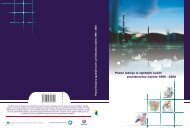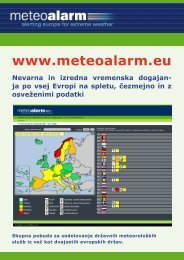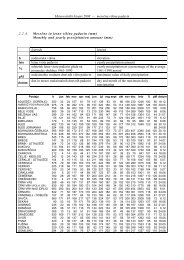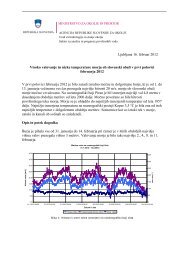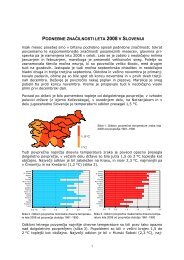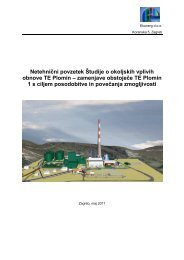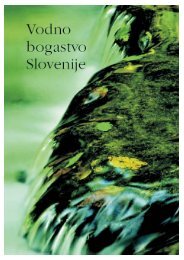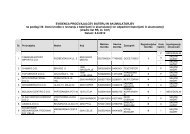Water Quality in Slovenia - Agencija RS za okolje
Water Quality in Slovenia - Agencija RS za okolje
Water Quality in Slovenia - Agencija RS za okolje
You also want an ePaper? Increase the reach of your titles
YUMPU automatically turns print PDFs into web optimized ePapers that Google loves.
56<br />
3.2<br />
W A T E R Q U A L I T Y I N S L O V E N I A<br />
Groundwater <strong>Quality</strong><br />
Groundwater quality is <strong>in</strong>fluenced by the activities on the Earth’s surface and by the vulnerability<br />
of aquifers. In flatland river valleys with predom<strong>in</strong>ant alluvial aquifers the conditions are ideal<br />
for <strong>in</strong>tensive agricultural production, <strong>in</strong> addition <strong>in</strong>dustrial and various craftsmen’s activities are<br />
also well developed. Settlements and traffic <strong>in</strong>frastructure are denser <strong>in</strong> these valleys compared<br />
to forested and mounta<strong>in</strong>ous regions of <strong>Slovenia</strong>. All the above-mentioned activities, together<br />
with a very high vulnerability, represent a high risk of groundwater pollution. In these aquifers the<br />
monitor<strong>in</strong>g results evidence that the groundwater is polluted by nitrates and pesticides orig<strong>in</strong>at<strong>in</strong>g<br />
mostly from the agricultural activity. Groundwater <strong>in</strong> some aquifers additionally conta<strong>in</strong>s chlor<strong>in</strong>ated<br />
organic solvents and heavy metals <strong>in</strong> concentrations above the quality standards. In aquifers with<br />
karst na fissure porosity, the pressures are less <strong>in</strong>tense compared to alluvial aquifers. Large parts of<br />
the surface above these aquifers are covered by forest, which provides natural protection for the<br />
groundwater. At the same time the land use is less <strong>in</strong>tensive, so groundwater pollution is lower <strong>in</strong><br />
these aquifers.<br />
The transport of pollution <strong>in</strong>to the groundwater and its spread<strong>in</strong>g around the aquifer depends<br />
on several factors, like the chemical and physical characteristics of the pollutant, the precipitation<br />
amount, the land use, the type of ground layers and the aquifer’s characteristics. Due to complex<br />
processes <strong>in</strong>fluenc<strong>in</strong>g the level of groundwater pollution, statistical methods and modell<strong>in</strong>g are<br />
<strong>in</strong>cluded <strong>in</strong> the <strong>in</strong>terpretation of the monitor<strong>in</strong>g results.<br />
National groundwater quality monitor<strong>in</strong>g, which has been carried out s<strong>in</strong>ce 1987 (66), is the<br />
systematic monitor<strong>in</strong>g of various physical and chemical parameters <strong>in</strong> groundwater bodies.<br />
Every year, the Environmental Agency of the Republic of <strong>Slovenia</strong> prepares <strong>in</strong> compliance with<br />
Slovene legislative acts for groundwater (67, 68, 69) the national groundwater quality monitor<strong>in</strong>g<br />
programme (70), and carries out all monitor<strong>in</strong>g phases. In accordance with the programme,<br />
authorised laboratories analyse about 150 different parameters <strong>in</strong> groundwater sampled at all the<br />
monitor<strong>in</strong>g sites twice to four times a year.<br />
A representative monitor<strong>in</strong>g network is the basis for a reliable chemical status assessment. National<br />
monitor<strong>in</strong>g network consists of monitor<strong>in</strong>g sites where groundwater is sampled. The monitor<strong>in</strong>g<br />
sites <strong>in</strong> alluvial aquifers are wells and boreholes, while <strong>in</strong> aquifers with karst and fissure porosity,<br />
the monitor<strong>in</strong>g sites are spr<strong>in</strong>gs and wells. In 2006, the national monitor<strong>in</strong>g network <strong>in</strong>cluded 129<br />
monitor<strong>in</strong>g sites, which were more concentrated <strong>in</strong> alluvial aquifers. A significant part of these wells<br />
and spr<strong>in</strong>gs is <strong>in</strong>tended for the dr<strong>in</strong>k<strong>in</strong>g water supply.<br />
Glijun spr<strong>in</strong>g Hubelj spr<strong>in</strong>g




